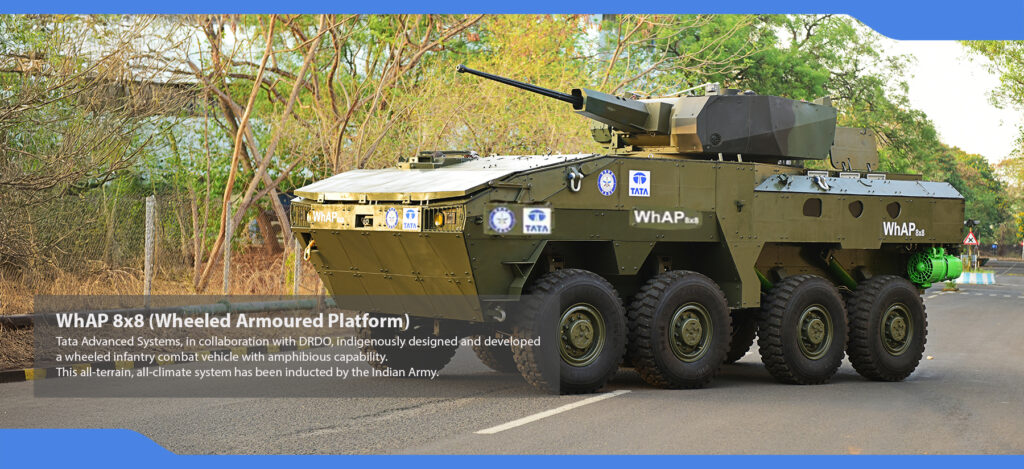The Indian Army’s mechanized infantry is on the cusp of a generational leap. On October 28, 2025, Tata Advanced Systems Limited (TASL) pulled the curtains off its latest creation — the Tracked Advanced Armoured Platform (TAAP) — a next-generation infantry combat vehicle (ICV) designed to become the backbone of India’s armoured formations in the coming decade. Unveiled at TASL’s Pune facility in the presence of senior Army officers and DRDO representatives, the TAAP is not just another incremental upgrade. It is a clean-sheet design that fuses cutting-edge mobility, survivability, modularity, and digital integration into a single platform — all under the banner of Atmanirbhar Bharat.
Genesis of a New War Machine:
The journey of the TAAP began in 2022 when the Indian Army issued a Request for Information (RFI) for a Future Infantry Combat Vehicle (FICV) under the Make-I category. The goal was clear: replace the ageing fleet of BMP-2 Sarath ICVs (over 2,500 in service) with a modern, indigenous platform capable of operating across India’s diverse terrain — from the high-altitude deserts of Ladakh to the riverine plains of Punjab and the dense jungles of the Northeast.
TASL, already a major player in India’s defence ecosystem with projects like the WhAP 8×8 wheeled platform and C-295 aircraft fuselage production, emerged as the frontrunner. Partnering with DRDO’s Combat Vehicles Research and Development Establishment (CVRDE) and global technology providers (under strict ToT clauses), TASL invested over ₹800 crore in R&D. The result? A 40-tonne tracked beast that promises to outgun, outmaneuver, and outlast its predecessor.
Design Philosophy: Modularity Meets Lethality
At the heart of the TAAP is modular architecture — a design trend seen in global platforms like Russia’s Kurganets-25 and Germany’s Lynx KF41. The vehicle features a universal chassis that can be configured into multiple variants:
Infantry Combat Vehicle (ICV): Carries 6+3 crew (driver, commander, gunner + 6 dismounts)
Command Post Vehicle
Anti-Tank Guided Missile (ATGM) Carrier
120mm Mortar Carrier
Engineer Recon Vehicle
This plug-and-play approach reduces lifecycle costs and simplifies logistics — a critical factor for the Indian Army, which operates one of the world’s largest armoured fleets.The baseline ICV variant unveiled on October 28 mounts a 30mm remote weapon station (RWS) co-developed with Bharat Forge and licensed from a European OEM. The cannon fires airburst munitions and is paired with a coaxial 7.62mm MG and dual Konkurs-M ATGM launchers. Future upgrades include integration of the DRDO Nag Mk-II or MPATGM once operational.
Mobility: Power Through Any Terrain
The TAAP is powered by a 1,000 hp indigenous powerpack — a joint development between Cummins India and CVRDE. This gives the vehicle a power-to-weight ratio of 25 hp/tonne — significantly higher than the BMP-2’s 17 hp/tonne. The hydropneumatic suspension and wide tracks ensure ground pressure below 0.7 kg/cm², enabling operations in soft soil and high-altitude zones.During trials at the Mahajan Field Firing Range in September 2025, the TAAP achieved:
Top speed: 70 km/h on road, 45 km/h cross-country
Gradient climb: 35°
Trench crossing: 2.5 meters
Fording depth: 1.2 meters (without preparation)
The vehicle also features silent watch capability via a lithium-ion auxiliary power unit (APU), allowing sensors and weapons to operate without the main engine — a game-changer for ambush and reconnaissance roles.
Survivability: A Fortress on Tracks
Survivability is where the TAAP truly shines. The hull uses composite ceramic armour with modular add-on panels — offering STANAG Level 4+ protection (resists 14.5mm AP rounds at 500m). An active protection system (APS) — likely a variant of DRDO’s Shakti EW suite — is integrated to defeat incoming RPGs and ATGMs.Additional features include:
360° situational awareness via 12 HD cameras and a panoramic commander’s sight
Laser warning receivers and smoke grenade launchers
NBC (nuclear, biological, chemical) protection with overpressure system
Automatic fire suppression
The vehicle’s low thermal and acoustic signature makes it harder to detect by enemy sensors — a critical advantage in peer conflicts.Digital Battlefield IntegrationThe TAAP is not just a tank on tracks — it’s a node in the digital battlefield. It is equipped with the Army’s Tactical Communication System (TCS) and Battlefield Management System (BMS), enabling real-time data sharing with drones, artillery, and air assets. The crew interfaces via touchscreen multifunction displays (MFDs) powered by a ruggedized AI co-processor that assists in:
Target prioritization
Route optimization
Predictive maintenance
The platform is also UAS-ready — capable of launching and recovering loitering munitions or nano-drones from a rear hatch.
Production & Timeline
TASL has already initiated Series Production Readiness at its Nagpur facility. The first 10 pre-production vehicles are undergoing user trials with the Mechanised Infantry Regiment in early 2026. Full-scale production is slated to begin in 2027, with an initial order of 1,300 units over 10 years.
The project cost is estimated at ₹18,000 crore, with 68% indigenous content at rollout — rising to 80% by 2030. TASL is also in talks with friendly foreign countries for export variants, positioning the TAAP as a competitor to the Korean AS21 Redback and Turkish Tulpar.
Strategic Implications
The TAAP is more than hardware — it’s a statement of intent. As India faces a two-front threat, the need for rapid, lethal, and survivable mechanized forces has never been greater. The platform fills a critical gap between the lightly armoured WhAP and the heavy T-90 tanks, creating a balanced, layered armoured ecosystem.It also cements the private sector’s role in India’s defence industrial base. With TASL leading design and integration, the TAAP proves that Indian companies can deliver world-class platforms without foreign hand-holding.
The Road Ahead
The TAAP is still in its infancy. Challenges remain:Integration of active protection systems
Scaling up indigenous powerpack production
Crew training for digital warfare
But the foundation is solid. As one Army officer present at the unveiling remarked (anonymously), “This is the first time we’re seeing a platform designed for 2040, not 1990.”The Tracked Advanced Armoured Platform is not just a vehicle. It is the future of Indian mechanized warfare — rolling, roaring, and ready.



